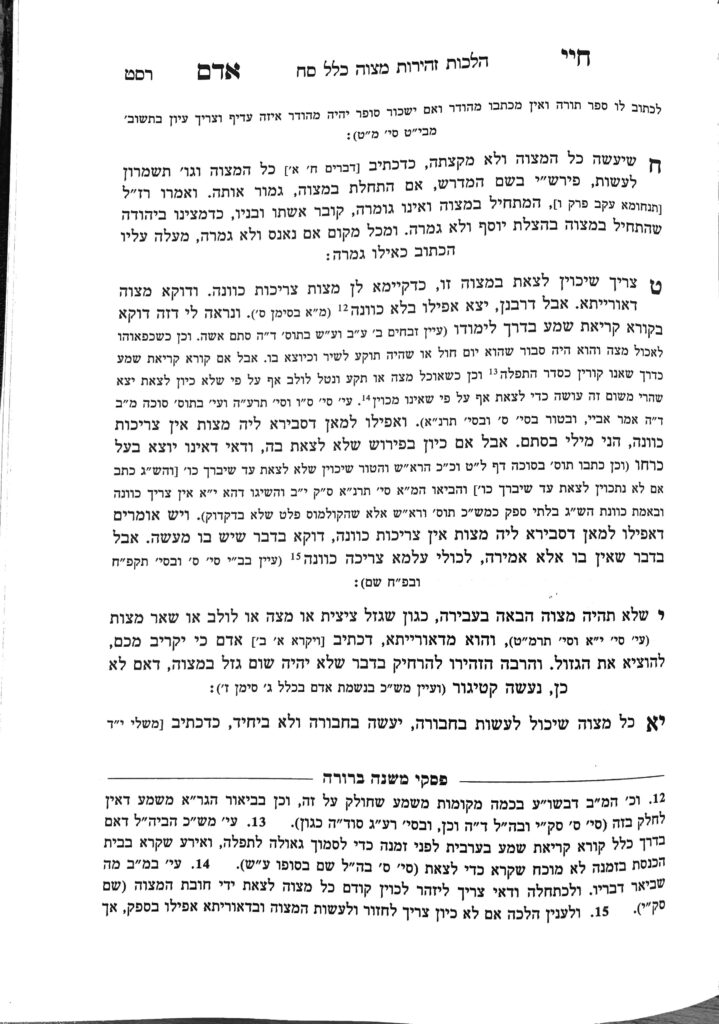We are continuing in siman 11, discussing the concept of b’rov am hadras melech. We left with a contradiction regarding the minimum amount of people considered b’rov am. The Chayei Adam says there must be a total of three people to be considered b’rov am, and the Mishnah Berurah quotes the Chayei Adam but writes in other places that a total of two people is considered b’rov am.
One possible answer is that there is a difference between the scenarios being discussed. In the scenarios where one person is saying a bracha and helping someone else fulfill their obligation, the other person is yotzei due to the concept of shomeah k’oneh. Shomeah k’oneh works because my action gets shared between the two of us, as we have learned previously (shiur 1409). The other scenario of b’rov am is where two people are individually performing a mitzvah simultaneously. The Chayei Adam is discussing the latter scenario, and holds that when each person is performing their own mitzvah, there needs to be three people present in order to gain the advantage of b’rov am. However, when one person is being motzi the other, since there is a more intrinsic connection between the people, two people are sufficient for b’rov am.
The idea that b’rov am is preferable is learned from the Gemara in Brachos. The Gemara discusses a group of people who wish to recite a bracha on a candle (not in the context of havdalah). Beis Hillel says that one person should recite the bracha for everyone, due to b’rov am. Beis Shammai holds that every person should recite the bracha to themselves, due to the bitul torah which will result from waiting for everyone to quiet down to be ready to recite the bracha. We see that Beis Shammai intrinsically agrees that b’rov am is preferable, he just argues that it is not worth it in light of the bitul torah.
Based on this concept, we learn that b’rov am is preferable in any scenario where one person is being motzi another, such as the examples of the Mishnah Berurah of tallis, hamotzi, and general brachos, and regarding kiddush as we discussed previously.
B’rov am also applies when multiple people perform the same mitzvah simultaneously, even though each person performs their own action. This form of b’rov am requires three people, as we learned above. The Mishnah Berurah, in hilchos kiddush levana, discusses whether it is preferable to perform kiddush levana b’rov am during the week b’rov am, or on Motzei Shabbos individually. He concludes that one should rather perform the mitzvah during the week and not wait until Motzei Shabbos. Although it is appropriate to recite kiddush levana in shabbos clothing, because one is greeting the shechina, b’rov am is still preferable.
If one has the option of reciting kiddush levana with a smaller group now, or a larger group later, the Mishnah Berurah brings the Eshel Avraham who holds that if the first group has less than 10 people, one should wait, but if the first group has 10, they should recite it with the first group, even if the second group will be larger. The Mishnah Berurah continues, and brings the Chayei Adam, who holds that three people are already considered b’rov am, so if the first group has three, one should recite kiddush levana with them, even if the second group will be larger. According to both the Eshel Avraham and Chayei Adam, we see that once the threshold of b’rov am has been reached, there does not appear to be a benefit to a larger group.
However, in siman 90, the Shulchan Aruch writes that it is appropriate to daven with the tzibbur. If there are two shuls available, each already with a minyan, one should daven in the shul with the larger tzibbur, due to the concept of b’rov am. The Chayei Adam finds a source to this idea from the pasuk we learned yesterday, that the kedusha increases exponentially with the greater amount of people. (The Mishnah Berurah points out that if the larger shul is distracting, one should not give up davening properly due to the benefit of b’rov am.)
Regarding kiddush levana, the Mishnah Berurah does not give preference to the larger group, as long as there are three. We will clarify this contradiction in the next shiur, be’ezras Hashem.
Summary
If one is performing a mitzvah to be motzi another through shomeah k’oneh, the advantage of b’rov am is achieved with a total of two people.
If a group of people are performing the same mitzvah simultaneously, the advantage of b’rov am is achieved with a total of three people.



